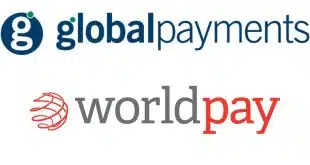The United States is way behind other markets in adopting tap-and-go cards. That’s about to change. Thad Peterson explains why.
The main benefit of EMV implementation is the virtual elimination of card-present counterfeit card fraud, and that alone is worth EMV’s massive infrastructure investment. But there’s another benefit to new point-of-sale installations.
Nearly all of the EMV terminals that have been installed in the U.S. also carry the ability to accept transactions through near-field communication, the contactless technology that Apple Pay, Google Pay, and Samsung Pay (“the Pays”) use.
Very cool stuff, and it works really well. But while usage of mobile wallets at POS is growing, it is still a small percentage of card-based payments in the U.S.
Before this year, the limited use of mobile wallets could be blamed on a lack of NFC-enabled terminals in the United States, but that is no longer the case. According to Visa, 79% of quick-serve restaurants, 77% of drugstores, and 61% of food and grocery stores can now accept a contactless transaction.
Beyond the Pays, there’s another way to make an NFC transaction: contactless, or dual-interface, cards. These cards have an NFC transmitter built in, along with EMV. The card can be used at an NFC terminal to make a contactless, “tap-and-go” transaction.
It’s just as safe as a traditional EMV transaction and really fast when compared with dipping or swiping the card, so it’s no surprise contactless cards have taken off in other markets. In the United Kingdom, for example, 78% of all debit cards and 62% of credit cards are dual-interface. Some 63% of U.K. consumers are regularly using the technology.
In the U.S., the number of contactless card transactions is less than the number of mobile-wallet transactions. In fact, it’s way less, like almost none.
This raises a few questions:
Why are contactless payments so popular in the U.K. and other markets?
First, when the British implemented EMV several years ahead of the U.S., it was a mandate. Merchants were required to install EMV-capable terminals, and card issuers were required to issue EMV cards. So adoption of the technology was rapid and universal. Along with EMV came the NFC capability, so the technology was generally available everywhere if merchants chose to turn it on.
In the U.S., EMV implementation is built around a shift of liability for fraudulent transactions from the issuer to the merchant if the card is EMV-enabled and the merchant cannot accept an EMV transaction. That made implementation erratic. Most large merchants implemented the technology quickly, but many smaller merchants chose to delay, or their implementations were delayed because of demand on the technology teams at the merchant processors.
Critical mass took several years to achieve, and there are still major categories like gas stations and high-end restaurants that have yet to implement. So, if EMV was being adopted slowly, NFC adoption was even slower.
Another major factor in the U.K. is that the London transit system had adopted a contactless card in 2012 for the London Underground and buses, and in 2014 for other rail transit. Since transit is the dominant travel option in London and rail is prevalent in the rest of the U.K., British consumers had adopted contactless years before EMV was implemented.
The cards used for transit could also be used to make purchases in transit stations, and from there the technology expanded to non-transit-related merchants. And U.K. card issuers began to offer contactless cards that could work with merchant terminals. There was very little behavioral change needed to go from “tap and go” on transit to “tap and pay” at a merchant location.
Why don’t we have them here?
With the slow growth of EMV, the number of NFC-enabled terminals was limited until fairly recently. Also, card issuers in the U.S. had only recently re-issued EMV chip cards to all of their customers, a costly effort, so there was little appetite to add even more cost to include a contactless capability and re-issue cards yet again.
Will we get them?
Yes! As mentioned above, NFC transactions are now being accepted at most fast-food restaurants, drugstores, and supermarkets, where everyday payments happen. That’s a huge change. There’s critical mass on the acceptance side.
On the issuing side, banks are starting to replace the first round of EMV cards, and if they have to do a re-issue, the cost of adding the contactless capability can be incorporated into the cost of re-issuance. Expect to see major issuers releasing contactless cards at scale in 2019. Visa is also aggressively promoting contactless in the U.S., so consumer awareness is rising.
What will happen when U.S. consumers get contactless cards?
Since NFC terminals have achieved critical mass and issuers are likely to release contactless cards in the next year, it’s likely that adoption of the technology will be good. But there’s another accelerant in the mix.
One of the reasons that adoption and usage of the “Pays” has been slow is that U.S. consumers are comfortable using cards for payment. So the vast majority do not see a mobile-wallet payment as an improvement over card transactions. With contactless, the existing consumer behavior—pulling a card out and paying—is exactly the same. The only thing that changes is how the consumer interacts with the terminal, and contactless is much, much faster than traditional EMV transactions.
Contactless card payments are more convenient than dipping or swiping and faster than traditional EMV, with the same security. And they don’t require any significant behavior change by consumers. All we need is to get the cards into their hands and contactless card usage in the U.S. will take off.
—Thad Peterson is a senior analyst at Aite Group LLC, Boston, Mass. Reach him at tpeterson@aitegroup.com.





